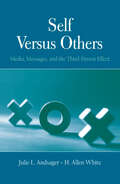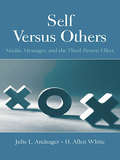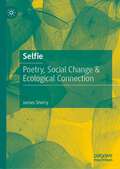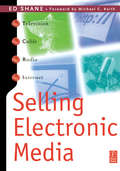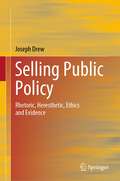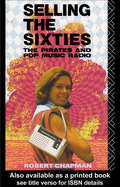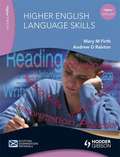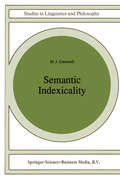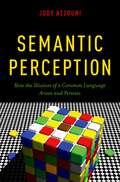- Table View
- List View
Self Versus Others: Media, Messages, and the Third-Person Effect (Routledge Communication Series)
by Julie L. Andsager H. Allen WhiteSelf Versus Others explores the third-person effect and its role in media as a means of persuasion. This scholarly work synthesizes more than two decades of research on the third-person effect, the process in which individuals do not perceive themselves to be impacted by particular messages—such as persuaded to engage in risky behaviors or encouraged to be violent—but they believe others will be. Authors Julie L. Andsager and H. Allen White focus their analysis specifically on the role of media and media messages, and assert that the third-person effect functions as a means of persuasion. They explore the underlying concepts and connections this effect shares with established theories of persuasion and mediated communication. The only volume to date focusing on the topic, Self Versus Others demonstrates the significant impact persuasion has on public opinion, behavior, and policy. As such, understanding the means through which persuasion can be accomplished thereby provides a powerful tool. Timely and succinct, this book:*provides thorough synthesis of third-person effect literature;*argues that systematic versus heuristic processing underlies third-person perceptions; and*conceptually links third-person effects with co-orientation. Intended for communication scholars with an interest in persuasion, as well as those in key areas including mass communication, health communication, and political communication, this book is also appropriate for advanced courses in persuasion, communication theory, and campaigns.
Self Versus Others: Media, Messages, and the Third-Person Effect (Routledge Communication Series)
by Julie L. Andsager H. Allen WhiteSelf Versus Others explores the third-person effect and its role in media as a means of persuasion. This scholarly work synthesizes more than two decades of research on the third-person effect, the process in which individuals do not perceive themselves to be impacted by particular messages—such as persuaded to engage in risky behaviors or encouraged to be violent—but they believe others will be. Authors Julie L. Andsager and H. Allen White focus their analysis specifically on the role of media and media messages, and assert that the third-person effect functions as a means of persuasion. They explore the underlying concepts and connections this effect shares with established theories of persuasion and mediated communication. The only volume to date focusing on the topic, Self Versus Others demonstrates the significant impact persuasion has on public opinion, behavior, and policy. As such, understanding the means through which persuasion can be accomplished thereby provides a powerful tool. Timely and succinct, this book:*provides thorough synthesis of third-person effect literature;*argues that systematic versus heuristic processing underlies third-person perceptions; and*conceptually links third-person effects with co-orientation. Intended for communication scholars with an interest in persuasion, as well as those in key areas including mass communication, health communication, and political communication, this book is also appropriate for advanced courses in persuasion, communication theory, and campaigns.
Selfie: Poetry, Social Change & Ecological Connection
by James SherrySelfie: Poetry, Social Change & Ecological Connection presents the first general theory that links poetry in environmental thought to poetry as an environment. James Sherry accomplishes this task with a network model of connectivity that scales from the individual to social to environmental practices. Selfie demonstrates how parts of speech, metaphor, and syntax extend bidirectionally from the writer to the world and from the writer inward to identities that promote sustainable practices. Selfie shows how connections in the biosphere scale up from operating within the body, to social structures, to the networks that science has identified for all life. The book urges readers to construct plural identifications rather than essential claims of identity in support of environmental diversity.
Sellevision: A Novel
by Augusten BurroughsThe hilarious first novel by the #1 bestselling author of Running with Scissors, Dry, A Wolf at the Table, and You Better Not Cry, Sellevision is Augusten Burrough's darkly funny and vastly entertaining skewering of a very troubled home-shopping channel.Welcome to the world of Sellevision, premier retail broadcasting network. When Max Andrews, the much loved and handsome (that is, lonely and gay) host of a "Toys for Tots" segment, accidentally exposes himself in front of millions of kids, Sellevision faces its first big scandal. As Max struggles to find a new job in television, the popular and perky host Peggy Jean Smythe is receiving sinister emails from a stalker. Popping pills and drinking heavily, she fails to notice that her husband is spending a lot of time with the young babysitter who lives next door. Then there's Leigh, whose affair with married Sellevision boss Howard Toast is going nowhere until she announces their relationship on air. A blistering satire of our overcharged, scandal-obsessed world, Sellevision is "an absolute howl . . . wicked fun" (New York Daily News)
Selling Electronic Media
by Ed Shane"Selling is identifying and satisfying customer needs profitably. Profitable for you, profitable for them."Diane Sutter, President and CEO of Shooting Star Broadcasting , owner of KTAB-TV, Abilene, TexasThis is the definition of sales used throughout Ed Shane's comprehensive and timely textbook Selling Electronic Media. This new definition reflects the customer-orientation of today's marketing environment as well as the product-orientation of selling. Today's selling is a win/win proposition, a win for the seller and a win for the customer.Using interviews with industry leaders and reports of their selling experiences, Selling Electronic Media shares insight and practical advice in the basics of selling: · prospecting· qualifying· needs analysis· presentations· answering objections· closing· relationship management Focusing on the merging and converging of electronic media and the need for branding of media at all levels, this highly readable book offers complete coverage of advertising sales for radio, television and cable, plus the new and emerging mass communication technologies, primarily those generated by the Internet.Selling Electronic Media is enhanced with review highlights and discussion points and illustrated throughout with visuals used by media outlets to market commercials and their audience reach.Students pursuing sales and marketing careers in electronic media and professionals wishing to reinforce their understanding of the merging and converging media environment will find what they need in the pages of this book.
Selling Electronic Media
by Ed Shane"Selling is identifying and satisfying customer needs profitably. Profitable for you, profitable for them."Diane Sutter, President and CEO of Shooting Star Broadcasting , owner of KTAB-TV, Abilene, TexasThis is the definition of sales used throughout Ed Shane's comprehensive and timely textbook Selling Electronic Media. This new definition reflects the customer-orientation of today's marketing environment as well as the product-orientation of selling. Today's selling is a win/win proposition, a win for the seller and a win for the customer.Using interviews with industry leaders and reports of their selling experiences, Selling Electronic Media shares insight and practical advice in the basics of selling: · prospecting· qualifying· needs analysis· presentations· answering objections· closing· relationship management Focusing on the merging and converging of electronic media and the need for branding of media at all levels, this highly readable book offers complete coverage of advertising sales for radio, television and cable, plus the new and emerging mass communication technologies, primarily those generated by the Internet.Selling Electronic Media is enhanced with review highlights and discussion points and illustrated throughout with visuals used by media outlets to market commercials and their audience reach.Students pursuing sales and marketing careers in electronic media and professionals wishing to reinforce their understanding of the merging and converging media environment will find what they need in the pages of this book.
Selling Public Policy: Rhetoric, Heresthetic, Ethics and Evidence
by Joseph DrewProfessor Drew’s latest work makes the case that even great public policy needs to be deliberately and strategically sold in order for it to ultimately be considered a success. However, it seems that most people charged with the task of selling public policy simply do not have the requisite skills to do so.Selling public policy is an art that draws on disparate strands of scholarship spanning the political sciences, economics, sociology, ethics and the classics. To perform the art of selling public policy one must first master the lessons from the greats in the field. Following this, it is necessary to learn how to apply the knowledge to real-world complex scenarios in such a way that the policy is indeed sold and stays sold over the implied returns period.This book is unique in the corpus of scholarly literature because it provides both the knowledge and real-world case studies required for students, scholars, and policy practitioners to master the art of selling public policy.
Selling the Sixties: The Pirates and Pop Music Radio
by Robert ChapmanWas it a non-stop psychedelic party or was there more to pirate radio in the sixties than hedonism and hip radicalism? From Kenny Everett's sacking to John Peel's legendary `Perfumed Garden' show, to the influence of the multi-national ad agencies, and the eventual assimilationof aspects of unofficial pop radio into Radio One, Selling the Sixties examines the boom of private broadcasting in Britain. Using two contrasting models of pop piracy, Radios Caroline and London, Robert Chapman sets pirate radio in its social and cultural context. In doing so he challenges the myths surrounding its maverick `Kings Road' image, separating populist consumerism from the economic and political machinations which were the flipside of the pirate phenomenon. Selling the Sixties includes previously unseen evidence from the pirates' archives, revealing interviews and an unrivalled selection of rare audio materials.
Selling the Sixties: The Pirates and Pop Music Radio
by Robert ChapmanWas it a non-stop psychedelic party or was there more to pirate radio in the sixties than hedonism and hip radicalism? From Kenny Everett's sacking to John Peel's legendary `Perfumed Garden' show, to the influence of the multi-national ad agencies, and the eventual assimilationof aspects of unofficial pop radio into Radio One, Selling the Sixties examines the boom of private broadcasting in Britain. Using two contrasting models of pop piracy, Radios Caroline and London, Robert Chapman sets pirate radio in its social and cultural context. In doing so he challenges the myths surrounding its maverick `Kings Road' image, separating populist consumerism from the economic and political machinations which were the flipside of the pirate phenomenon. Selling the Sixties includes previously unseen evidence from the pirates' archives, revealing interviews and an unrivalled selection of rare audio materials.
Selling the Story: Transaction and Narrative Value in Balzac, Dostoevsky, and Zola
by Jonathan PaineEvery writer is a player in the marketplace for literature. Jonathan Paine locates the economics ingrained within the stories themselves, showing how the business of literature affects even storytelling devices such as genre, plot, and repetition. In this new model of criticism, the text is a record of its author’s sales pitch.
SEM Scottish Examination Materials: English Language Skills for Higher English (PDF)
by M. Mary Firth Andrew G. RalstonEven for unseen elements of the Higher English examination, such as the interpretation section, there are skills a student can practice to improve their performance. A good writing style is of great importantance to an examiner and pupils must demonstrate thier abilities in word choice, sentence structure, tone, imagery, punctuation etc. This book will explain the techniques required to become a good writer. It will also teach pupils how to recognise the demands of a question, providing an understanding of the phrasing and proposing methods of approaching writing an appropriate response.
Semantic Analysis of Verbal Collocations with Lexical Functions (Studies in Computational Intelligence #414)
by Alexander Gelbukh Olga KolesnikovaThis book is written for both linguists and computer scientists working in the field of artificial intelligence as well as to anyone interested in intelligent text processing. Lexical function is a concept that formalizes semantic and syntactic relations between lexical units. Collocational relation is a type of institutionalized lexical relations which holds between the base and its partner in a collocation. Knowledge of collocation is important for natural language processing because collocation comprises the restrictions on how words can be used together. The book shows how collocations can be annotated with lexical functions in a computer readable dictionary - allowing their precise semantic analysis in texts and their effective use in natural language applications including parsers, high quality machine translation, periphrasis system and computer-aided learning of lexica. The books shows how to extract collocations from corpora and annotate them with lexical functions automatically. To train algorithms, the authors created a dictionary of lexical functions containing more than 900 Spanish disambiguated and annotated examples which is a part of this book. The obtained results show that machine learning is feasible to achieve the task of automatic detection of lexical functions.
A Semantic and Pragmatic Model of Lexical and Grammatical Aspect (Outstanding Dissertations in Linguistics)
by Mari B. OlsenFirst Published in 1997. This work studies two related phenomena in human language: the ability of verbs and other lexical items to describe how a situation (event or state) develops or holds in time (LEXICAL ASPECT) and the view some verbal auxiliaries and affixes present of the development or result of a situation at a given time (GRAMMATICAL ASPECT). Through this investigation the author seeks to reveal a formal situation structure represented by aspectual phenomena, a structure to which other linguistic elements make reference, particularly tense. This structure describes the semantics of aspect and provides a principled input to pragmatic aspectual interpretation.
A Semantic and Pragmatic Model of Lexical and Grammatical Aspect (Outstanding Dissertations in Linguistics)
by Mari B. OlsenFirst Published in 1997. This work studies two related phenomena in human language: the ability of verbs and other lexical items to describe how a situation (event or state) develops or holds in time (LEXICAL ASPECT) and the view some verbal auxiliaries and affixes present of the development or result of a situation at a given time (GRAMMATICAL ASPECT). Through this investigation the author seeks to reveal a formal situation structure represented by aspectual phenomena, a structure to which other linguistic elements make reference, particularly tense. This structure describes the semantics of aspect and provides a principled input to pragmatic aspectual interpretation.
Semantic Change and Collective Knowledge in 18th Century Britain
by John ReganAn in-depth digital investigation of several 18th-century British corpora, this book identifies shared communities of meaning in the printed British 18th century by highlighting and analysing patterns in the distribution of lexis. There are forces of attraction between words: some are more likely to keep company than others, and how words attract and repel one another is worthy of note. Charting these forces, this book demonstrates how distant reading 18th-century corpora can tell us something new, methodologically defensible and, crucially, interesting, about the most common constructions of word meanings and epistemes in the printed British 18th century. In the case studies in this book, computation brings to light some remarkable facts about collectively-produced forms of meaning, without which the most common meanings of words, and the ways of knowing that they constituted, would remain matters of conjecture rather than evidence. Providing the first investigation of collective meaning and knowledge in the British 18th century, this interdisciplinary study builds on the existing stores of close reading, praxis, and history of ideas, presenting a view constructed at scale, rather than at the level of individual texts.
Semantic Change and Collective Knowledge in 18th Century Britain
by John ReganAn in-depth digital investigation of several 18th-century British corpora, this book identifies shared communities of meaning in the printed British 18th century by highlighting and analysing patterns in the distribution of lexis. There are forces of attraction between words: some are more likely to keep company than others, and how words attract and repel one another is worthy of note. Charting these forces, this book demonstrates how distant reading 18th-century corpora can tell us something new, methodologically defensible and, crucially, interesting, about the most common constructions of word meanings and epistemes in the printed British 18th century. In the case studies in this book, computation brings to light some remarkable facts about collectively-produced forms of meaning, without which the most common meanings of words, and the ways of knowing that they constituted, would remain matters of conjecture rather than evidence. Providing the first investigation of collective meaning and knowledge in the British 18th century, this interdisciplinary study builds on the existing stores of close reading, praxis, and history of ideas, presenting a view constructed at scale, rather than at the level of individual texts.
Semantic Control for the Cybersecurity Domain: Investigation on the Representativeness of a Domain-Specific Terminology Referring to Lexical Variation
by Claudia LanzaThis book presents the creation of a bilingual thesaurus (Italian and English), and its conversion into an ontology system, oriented to the Cybersecurity field of knowledge term management and the identification of a replicable method over other specialized areas of study, through computational linguistics procedures, to a statistical and qualitative measurement of the terminological coverage threshold a controlled vocabulary is able to guarantee with respect to the semantic richness proper to the domain under investigation. The volume empowers readers to compile and study significant corpora documentations to support the text mining tasks and to establish a representativeness evaluation of the information retrieved. Through a description of several techniques belonging to the field of linguistics and knowledge engineering, this monograph provides a methodological account on how to enhance and update semantic monitoring tools reflecting a specialized lexicon as that of Cybersecurity to grant a reference semantic structure for domain-sector text classification tasks. This volume is a valuable reference to scholars of corpus-based studies, terminology, ICT, documentation and librarianship studies, text processing research, and distributional semantics area of interest as well as for professionals involved in Cybersecurity organizations.
Semantic Control for the Cybersecurity Domain: Investigation on the Representativeness of a Domain-Specific Terminology Referring to Lexical Variation
by Claudia LanzaThis book presents the creation of a bilingual thesaurus (Italian and English), and its conversion into an ontology system, oriented to the Cybersecurity field of knowledge term management and the identification of a replicable method over other specialized areas of study, through computational linguistics procedures, to a statistical and qualitative measurement of the terminological coverage threshold a controlled vocabulary is able to guarantee with respect to the semantic richness proper to the domain under investigation. The volume empowers readers to compile and study significant corpora documentations to support the text mining tasks and to establish a representativeness evaluation of the information retrieved. Through a description of several techniques belonging to the field of linguistics and knowledge engineering, this monograph provides a methodological account on how to enhance and update semantic monitoring tools reflecting a specialized lexicon as that of Cybersecurity to grant a reference semantic structure for domain-sector text classification tasks. This volume is a valuable reference to scholars of corpus-based studies, terminology, ICT, documentation and librarianship studies, text processing research, and distributional semantics area of interest as well as for professionals involved in Cybersecurity organizations.
Semantic Domains in Computational Linguistics
by Alfio Gliozzo Carlo StrapparavaSemantic fields are lexically coherent – the words they contain co-occur in texts. In this book the authors introduce and define semantic domains, a computational model for lexical semantics inspired by the theory of semantic fields. Semantic domains allow us to exploit domain features for texts, terms and concepts, and they can significantly boost the performance of natural-language processing systems. Semantic domains can be derived from existing lexical resources or can be acquired from corpora in an unsupervised manner. They also have the property of interlinguality, and they can be used to relate terms in different languages in multilingual application scenarios. The authors give a comprehensive explanation of the computational model, with detailed chapters on semantic domains, domain models, and applications of the technique in text categorization, word sense disambiguation, and cross-language text categorization. This book is suitable for researchers and graduate students in computational linguistics.
Semantic Externalism (New Problems of Philosophy)
by Jesper KallestrupSemantic externalism is the view that the meanings of referring terms, and the contents of beliefs that are expressed by those terms, are not fully determined by factors internal to the speaker but are instead bound up with the environment. The debate about semantic externalism is one of the most important but difficult topics in philosophy of mind and language, and has consequences for our understanding of the role of social institutions and the physical environment in constituting language and the mind. In this long-needed book, Jesper Kallestrup provides an invaluable map of the problem. Beginning with a thorough introduction to the theories of descriptivism and referentialism and the work of Frege and Kripke, Kallestrup moves on to analyse Putnam’s Twin Earth argument, Burge’s arthritis argument and Davidson’s Swampman argument. He also discusses how semantic externalism is at the heart of important topics such as indexical thoughts, epistemological skepticism, self-knowledge, and mental causation. Including chapter summaries, a glossary of terms, and an annotated guide to further reading, Semantic Externalism an ideal guide for students studying philosophy of language and philosophy of mind.
Semantic Externalism (New Problems of Philosophy)
by Jesper KallestrupSemantic externalism is the view that the meanings of referring terms, and the contents of beliefs that are expressed by those terms, are not fully determined by factors internal to the speaker but are instead bound up with the environment. The debate about semantic externalism is one of the most important but difficult topics in philosophy of mind and language, and has consequences for our understanding of the role of social institutions and the physical environment in constituting language and the mind. In this long-needed book, Jesper Kallestrup provides an invaluable map of the problem. Beginning with a thorough introduction to the theories of descriptivism and referentialism and the work of Frege and Kripke, Kallestrup moves on to analyse Putnam’s Twin Earth argument, Burge’s arthritis argument and Davidson’s Swampman argument. He also discusses how semantic externalism is at the heart of important topics such as indexical thoughts, epistemological skepticism, self-knowledge, and mental causation. Including chapter summaries, a glossary of terms, and an annotated guide to further reading, Semantic Externalism an ideal guide for students studying philosophy of language and philosophy of mind.
Semantic Indexicality (Studies in Linguistics and Philosophy #60)
by M.J. CresswellSemantic Indexicality shows how a simple syntax can be combined with a propositional language at the level of logical analysis. It is the adoption of such a base language which has not been attempted before, and it is this which constitutes the originality of the book. Cresswell's simple and direct style makes this book accessible to a wider audience than the somewhat specialized subject matter might initially suggest.
Semantic Mechanisms of Humor (Studies in Linguistics and Philosophy #24)
by V. RaskinGOAL This is the funniest book I have ever written - and the ambiguity here is deliberate. Much of this book is about deliberate ambiguity, described as unambiguously as possible, so the previous sentence is probably the fIrst, last, and only deliberately ambiguous sentence in the book. Deliberate ambiguity will be shown to underlie much, if not all, of verbal humor. Some of its forms are simple enough to be perceived as deliberately ambiguous on the surface; in others, the ambiguity results from a deep semantic analysis. Deep semantic analysis is the core of this approach to humor. The book is the fIrst ever application of modem linguistic theory to the study of humor and it puts forward a formal semantic theory of verbal humor. The goal of the theory is to formulate the necessary and sufficient conditions, in purely semantic terms, for a text to be funny. In other words, if a formal semantic analysis of a text yields a certain set of semantic proptrties which the text possesses, then the text is recognized as a joke. As any modem linguistic theory, this semantic theory of humor attempts to match a natural intuitive ability which the native speaker has, in this particular case, the ability to perceive a text as funny, i. e. , to distinguish a joke from a non-joke.
